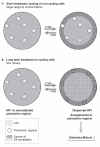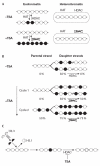The effects of histone deacetylase inhibitors on heterochromatin: implications for anticancer therapy?
- PMID: 15940285
- PMCID: PMC1369099
- DOI: 10.1038/sj.embor.7400441
The effects of histone deacetylase inhibitors on heterochromatin: implications for anticancer therapy?
Abstract
Histone acetylation regulates many chromosome functions, such as gene expression and chromosome segregation. Histone deacetylase inhibitors (HDACIs) induce growth arrest, differentiation and apoptosis of cancer cells ex vivo, as well as in vivo in tumour-bearing animal models, and are now undergoing clinical trials as anti-tumour agents. However, little attention has been paid to how HDACIs function in these biological settings and why different cells respond in different ways. Here, we discuss the consequences of inhibiting histone deacetylases in cycling versus non-cycling cells, in light of the dynamics of histone acetylation patterns with a specific emphasis on heterochromatic regions of the genome.
Figures


Similar articles
-
Reversible disruption of pericentric heterochromatin and centromere function by inhibiting deacetylases.Nat Cell Biol. 2001 Feb;3(2):114-20. doi: 10.1038/35055010. Nat Cell Biol. 2001. PMID: 11175742
-
Application of the histone deacetylase inhibitors for the treatment of endometriosis: histone modifications as pathogenesis and novel therapeutic target.Hum Reprod. 2011 Sep;26(9):2486-98. doi: 10.1093/humrep/der203. Epub 2011 Jun 29. Hum Reprod. 2011. PMID: 21715447
-
Histone deacetylase inhibition redistributes topoisomerase IIβ from heterochromatin to euchromatin.Nucleus. 2011 Jan-Feb;2(1):61-71. doi: 10.4161/nucl.2.1.14194. Nucleus. 2011. PMID: 21647300 Free PMC article.
-
Regulation of apoptosis-associated genes by histone deacetylase inhibitors: implications in cancer therapy.Anticancer Drugs. 2010 Oct;21(9):805-13. doi: 10.1097/CAD.0b013e32833dad91. Anticancer Drugs. 2010. PMID: 20679890 Review.
-
Histone deacetylase inhibitors as new cancer drugs.Curr Opin Oncol. 2001 Nov;13(6):477-83. doi: 10.1097/00001622-200111000-00010. Curr Opin Oncol. 2001. PMID: 11673688 Review.
Cited by
-
Histone modifications and nuclear architecture: a review.J Histochem Cytochem. 2008 Aug;56(8):711-21. doi: 10.1369/jhc.2008.951251. Epub 2008 May 12. J Histochem Cytochem. 2008. PMID: 18474937 Free PMC article. Review.
-
Tissue-specific effects of valproic acid on DNA repair genes and apoptosis in postimplantation mouse embryos.Toxicol Sci. 2014 Sep;141(1):59-67. doi: 10.1093/toxsci/kfu105. Epub 2014 Jun 9. Toxicol Sci. 2014. PMID: 24913804 Free PMC article.
-
Reversibility of membrane N-glycome of HeLa cells upon treatment with epigenetic inhibitors.PLoS One. 2013;8(1):e54672. doi: 10.1371/journal.pone.0054672. Epub 2013 Jan 15. PLoS One. 2013. PMID: 23336012 Free PMC article.
-
Chromatin structure exhibits spatio-temporal heterogeneity within the cell nucleus.Biophys J. 2006 Sep 15;91(6):2297-303. doi: 10.1529/biophysj.105.079525. Epub 2006 Jun 30. Biophys J. 2006. PMID: 16815897 Free PMC article.
-
Histone deacetylase inhibition accelerates the early events of stem cell differentiation: transcriptomic and epigenetic analysis.Genome Biol. 2008 Apr 4;9(4):R65. doi: 10.1186/gb-2008-9-4-r65. Genome Biol. 2008. PMID: 18394158 Free PMC article.
References
-
- Almouzni G, Khochbin S, Dimitrov S, Wolffe AP (1994) Histone acetylation influences both gene expression and development of Xenopus laevis. Dev Biol 165: 654–669 - PubMed
-
- Craig JM, Earle E, Canham P, Wong LH, Anderson M, Choo KH (2003) Analysis of mammalian proteins involved in chromatin modification reveals new metaphase centromeric proteins and distinct chromosomal distribution patterns. Hum Mol Genet 12: 3109–3121 - PubMed
Publication types
MeSH terms
Substances
LinkOut - more resources
Full Text Sources
Other Literature Sources

